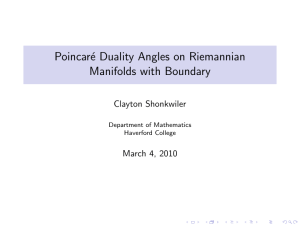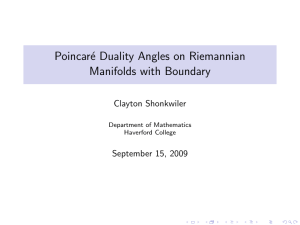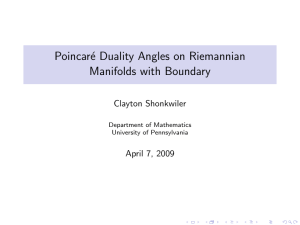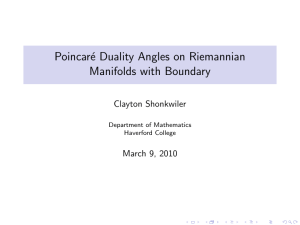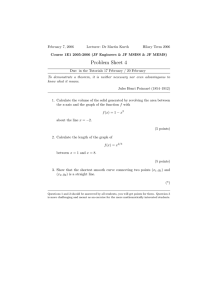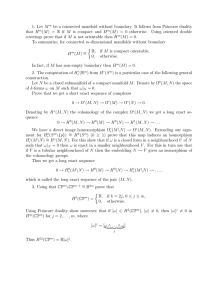Poincar´ e Duality Angles on Riemannian Manifolds with Boundary Clayton Shonkwiler
advertisement
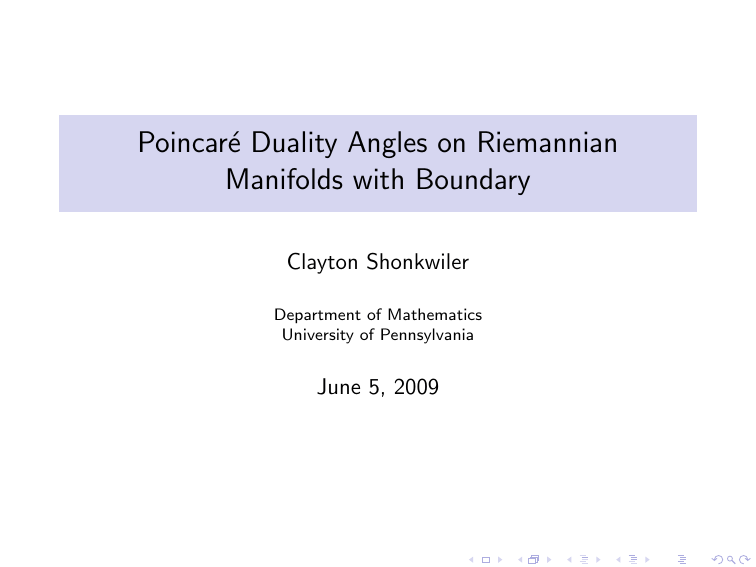
Poincaré Duality Angles on Riemannian
Manifolds with Boundary
Clayton Shonkwiler
Department of Mathematics
University of Pennsylvania
June 5, 2009
Realizing cohomology groups as spaces of differential forms
Let M n be a compact Riemannian manifold with non-empty
boundary ∂M.
Realizing cohomology groups as spaces of differential forms
CO-EXACT NEUMANN FORMS HAVE CO-CLOSED
TRACES
H
)
p
;R
(M
,∂
(M
M
p
H
;R
)
Let M n be a compact Riemannian manifold with non-empty
boundary ∂M.
CLAYTON SHONKWILER
Figure 1. The concrete realizations of the absolute and relative cohomology groups
de Rham’s Theorem
de Rham’s Theorem
Suppose M n is a compact, oriented, smooth manifold. Then
H p (M; R) ∼
= C p (M)/E p (M),
where C p (M) is the space of closed p-forms on M and E p (M) is
the space of exact p-forms.
Riemannian metric
If M is Riemannian, the metric induces an L2 inner product on
Ωp (M):
Z
hω, ηi :=
ω ∧ ? η.
M
Riemannian metric
If M is Riemannian, the metric induces an L2 inner product on
Ωp (M):
Z
hω, ηi :=
ω ∧ ? η.
M
When M is closed, the orthogonal complement of E p (M) inside
C p (M) is
Hp (M) := {ω ∈ Ωp (M) : dω = 0, δω = 0}
Riemannian metric
If M is Riemannian, the metric induces an L2 inner product on
Ωp (M):
Z
hω, ηi :=
ω ∧ ? η.
M
When M is closed, the orthogonal complement of E p (M) inside
C p (M) is
Hp (M) := {ω ∈ Ωp (M) : dω = 0, δω = 0}
Kodaira called this the space of harmonic p-fields on M.
Hodge’s Theorem
Hodge’s Theorem
If M n is a closed, oriented, smooth Riemannian manifold,
H p (M; R) ∼
= Hp (M).
Hodge–Morrey–Friedrichs Decomposition
Define i : ∂M ,→ M to be the natural inclusion.
Hodge–Morrey–Friedrichs Decomposition
Define i : ∂M ,→ M to be the natural inclusion.
The L2 -orthogonal complement of the exact forms inside the space
of closed forms is now:
p
HN
(M) := {ω ∈ Ωp (M) : dω = 0, δω = 0, i ∗ ? ω = 0}.
Hodge–Morrey–Friedrichs Decomposition
Define i : ∂M ,→ M to be the natural inclusion.
The L2 -orthogonal complement of the exact forms inside the space
of closed forms is now:
p
HN
(M) := {ω ∈ Ωp (M) : dω = 0, δω = 0, i ∗ ? ω = 0}.
Then
p
H p (M; R) ∼
= HN (M).
Hodge–Morrey–Friedrichs Decomposition (continued)
The relative cohomology appears as
p
H p (M, ∂M; R) ∼
= HD (M).
Hodge–Morrey–Friedrichs Decomposition (continued)
The relative cohomology appears as
p
H p (M, ∂M; R) ∼
= HD (M).
p
HD
(M) := {ω ∈ Ωp (M) : dω = 0, δω = 0, i ∗ ω = 0}.
Non-orthogonality
The concrete realizations of H p (M; R) and H p (M, ∂M; R) meet
only at the origin:
p
p
HN
(M) ∩ HD
(M) = {0}
Non-orthogonality
The concrete realizations of H p (M; R) and H p (M, ∂M; R) meet
only at the origin:
p
p
HN
(M) ∩ HD
(M) = {0}
...but they are not orthogonal!
Non-orthogonality
The concrete realizations of H p (M; R) and H p (M, ∂M; R) meet
only at the origin:
CO-EXACT NEUMANN FORMS HAVE CO-CLOSED
p
p
HN
(M) ∩
HD
(M) = {0}
TRACES
CLAYTON SHONKWILER
...but they are not orthogonal!
un
(M
)
bo
D
p
r
H
r
interio
)
interio
M
p (
HN
ry
da
un
da
ry
bo
Figure 1. The concrete realizations of the absolute and rel-
Interior and boundary subspaces
p
Interior subspace of HN
(M):
ker i ∗ where i ∗ : H p (M; R) → H p (∂M; R)
Interior and boundary subspaces
p
Interior subspace of HN
(M):
ker i ∗ where i ∗ : H p (M; R) → H p (∂M; R)
p
p
E∂ HN
(M) := {ω ∈ HN
(M) : i ∗ ω = dϕ, ϕ ∈ Ωp−1 (∂M)}.
Interior and boundary subspaces
p
Interior subspace of HN
(M):
ker i ∗ where i ∗ : H p (M; R) → H p (∂M; R)
p
p
E∂ HN
(M) := {ω ∈ HN
(M) : i ∗ ω = dϕ, ϕ ∈ Ωp−1 (∂M)}.
p
Interior subspace of HD
(M):
n−p
p
(M) = cE∂ HD
(M)
? E∂ HN
p
= {η ∈ HD
(M) : i ∗ ? η = dψ, ψ ∈ Ωn−p−1 (∂M)}.
∂
N
N
N
subspaces, as claimed in (2.1.8). This completes the proof of the theorem.
Poincaré duality angles
Theorem 2.1.2 allows the details of Figure 1.1 to be filled in, as shown in Figure 2.1.
p
(M
)
H
cE
)
N
D
H
E∂ H p (M
p (M )
cE∂ H D
)
)
p
(M
)
EH
D
(M
p
N
M
p (
HN
p
p
Figure 2.1: HN
(M ) and HD
(M )
Definition (DeTurck–Gluck)
The Poincaré duality angles of the Riemannian manifold M are the
18
principal angles between the interior
subspaces.
What do the Poincaré duality angles tell you?
Guess
If M is “almost” closed, the Poincaré duality angles of M should
be small.
For example...
Consider CP2 with its usual Fubini-Study metric. Let p ∈ CP2 .
Then define
Mr := CP2 − Br (p).
For example...
Consider CP2 with its usual Fubini-Study metric. Let p ∈ CP2 .
Then define
Mr := CP2 − Br (p).
π/2
CP1
p
Topology of Mr
∂Mr is a 3-sphere.
Topology of Mr
∂Mr is a 3-sphere.
Mr is the D 2 -bundle over CP1 (' S 2 (1/2)) with Euler
characteristic 1.
Topology of Mr
∂Mr is a 3-sphere.
Mr is the D 2 -bundle over CP1 (' S 2 (1/2)) with Euler
characteristic 1.
Mr has absolute cohomology in dimensions 0 and 2.
Topology of Mr
∂Mr is a 3-sphere.
Mr is the D 2 -bundle over CP1 (' S 2 (1/2)) with Euler
characteristic 1.
Mr has absolute cohomology in dimensions 0 and 2.
Mr has relative cohomology in dimensions 2 and 4.
Topology of Mr
∂Mr is a 3-sphere.
Mr is the D 2 -bundle over CP1 (' S 2 (1/2)) with Euler
characteristic 1.
Mr has absolute cohomology in dimensions 0 and 2.
Mr has relative cohomology in dimensions 2 and 4.
Therefore, Mr has a single Poincaré duality angle θr between
2 (M ) and H2 (M ).
HN
r
r
D
Find harmonic 2-fields
So the goal is to find closed and co-closed 2-forms on Mr which
satisfy Neumann and Dirichlet boundary conditions.
Find harmonic 2-fields
So the goal is to find closed and co-closed 2-forms on Mr which
satisfy Neumann and Dirichlet boundary conditions.
Such 2-forms must be isometry-invariant.
Find harmonic 2-fields
So the goal is to find closed and co-closed 2-forms on Mr which
satisfy Neumann and Dirichlet boundary conditions.
Such 2-forms must be isometry-invariant.
Isom0 (Mr ) = SU(2).
Find harmonic 2-fields
So the goal is to find closed and co-closed 2-forms on Mr which
satisfy Neumann and Dirichlet boundary conditions.
Such 2-forms must be isometry-invariant.
Isom0 (Mr ) = SU(2).
Find closed and co-closed SU(2)-invariant forms on Mr satisfying
Neumann and Dirichlet boundary conditions
The Poincaré duality angle for Mr
cos θr =
1 − sin4 r
.
1 + sin4 r
The Poincaré duality angle for Mr
cos θr =
1 − sin4 r
.
1 + sin4 r
As r → 0, the Poincaré duality angle θr → 0.
The Poincaré duality angle for Mr
cos θr =
1 − sin4 r
.
1 + sin4 r
As r → 0, the Poincaré duality angle θr → 0.
As r → π/2, θr → π/2.
The Poincaré duality angle for Mr
cos θr =
1 − sin4 r
.
1 + sin4 r
As r → 0, the Poincaré duality angle θr → 0.
As r → π/2, θr → π/2.
Generalizes to CPn − Br (p).
Poincaré duality angles of Grassmannians
Consider
Nr := G2 Rn − νr (G1 Rn−1 ).
Poincaré duality angles of Grassmannians
Consider
Nr := G2 Rn − νr (G1 Rn−1 ).
Theorem
• As r → 0, all the Poincaré duality angles of Nr go to zero.
• As r approaches its maximum value of π/2, all the Poincaré
duality angles of Nr go to π/2.
A conjecture
Conjecture
If M n is a closed Riemannian manifold and N k is a closed
submanifold of codimension ≥ 2, the Poincaré duality angles of
M − νr (N)
go to zero as r → 0.
A question
What can you learn about the topology of M from knowledge of ∂M?
Electrical Impedance Tomography
Induce potentials on the boundary of a region and determine the
conductivity inside the region by measuring the current flux
through the boundary.
Electrical Impedance Tomography
Induce potentials on the boundary of a region and determine the
conductivity inside the region by measuring the current flux
through the boundary.
The Voltage-to-Current map
Suppose f is a potential on the boundary of a region M ⊂ R3 .
The Voltage-to-Current map
Suppose f is a potential on the boundary of a region M ⊂ R3 .
Then f extends to a potential u on M, where
∆u = 0,
u|∂M = f .
The Voltage-to-Current map
Suppose f is a potential on the boundary of a region M ⊂ R3 .
Then f extends to a potential u on M, where
∆u = 0,
u|∂M = f .
If γ is the conductivity on M, the current flux through ∂M is given
by
∂u
(γ∇u) · ν = −γ
∂ν
The Dirichlet-to-Neumann map
The map Λcl : C ∞ (∂M) → C ∞ (∂M) defined by
f 7→
∂u
∂ν
is the classical Dirichlet-to-Neumann map.
The Dirichlet-to-Neumann map
The map Λcl : C ∞ (∂M) → C ∞ (∂M) defined by
f 7→
∂u
∂ν
is the classical Dirichlet-to-Neumann map.
Theorem (Lee-Uhlmann)
If M n is a compact, analytic Riemannian manifold with boundary,
then M is determined up to isometry by Λcl .
Generalization to differential forms
Joshi–Lionheart and Belishev–Sharafutdinov generalized the
classical Dirichlet-to-Neumann map to differential forms:
Λ : Ωp (∂M) → Ωn−p−1 (∂M)
Generalization to differential forms
Joshi–Lionheart and Belishev–Sharafutdinov generalized the
classical Dirichlet-to-Neumann map to differential forms:
Λ : Ωp (∂M) → Ωn−p−1 (∂M)
Theorem (Belishev–Sharafutdinov)
The data (∂M, Λ) completely determines the cohomology groups
of M.
Connection to Poincaré duality angles
Define the Hilbert transform T := dΛ−1 .
Connection to Poincaré duality angles
Define the Hilbert transform T := dΛ−1 .
Theorem
If θ1 , . . . , θk are the Poincaré duality angles of M in dimension p,
then the quantities
(−1)np+n+p cos2 θi
are the non-zero eigenvalues of an appropriate restriction of T 2 .
Cup products
Belishev and Sharafutdinov posed the following question:
Can the multiplicative structure of cohomologies be
recovered from our data (∂M, Λ)? Till now, the authors
cannot answer the question.
Cup products
Belishev and Sharafutdinov posed the following question:
Can the multiplicative structure of cohomologies be
recovered from our data (∂M, Λ)? Till now, the authors
cannot answer the question.
Theorem
The mixed cup product
∪ : H p (M; R) × H q (M, ∂M; R) → H p+q (M, ∂M; R)
is completely determined by the data (∂M, Λ) when the relative
class is restricted to come from the boundary subspace.
Some questions
• Poincaré duality angles for G4 R8 − νr (G3 R7 )? Other
“Grassmann manifolds with boundary”?
Some questions
• Poincaré duality angles for G4 R8 − νr (G3 R7 )? Other
“Grassmann manifolds with boundary”?
• What is the limiting behavior of the Poincaré duality angles as
the manifold “closes up”?
Some questions
• Poincaré duality angles for G4 R8 − νr (G3 R7 )? Other
“Grassmann manifolds with boundary”?
• What is the limiting behavior of the Poincaré duality angles as
the manifold “closes up”?
• Can the full mixed cup product be recovered from (∂M, Λ)?
What about other cup products?
Some questions
• Poincaré duality angles for G4 R8 − νr (G3 R7 )? Other
“Grassmann manifolds with boundary”?
• What is the limiting behavior of the Poincaré duality angles as
the manifold “closes up”?
• Can the full mixed cup product be recovered from (∂M, Λ)?
What about other cup products?
p
p
• Can the L2 inner product on HN
(M) and HD
(M) be
recovered from (∂M, Λ)?
Thanks!
